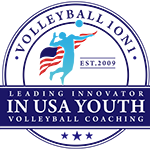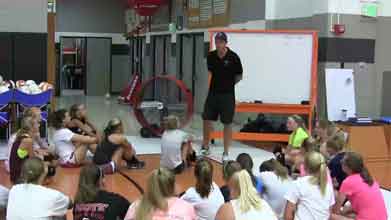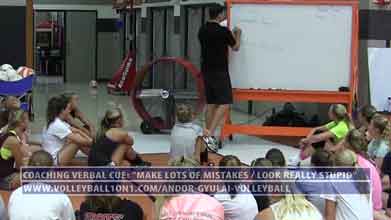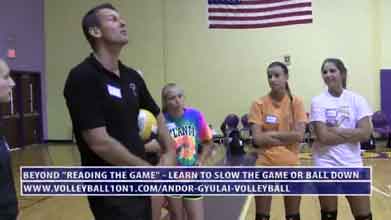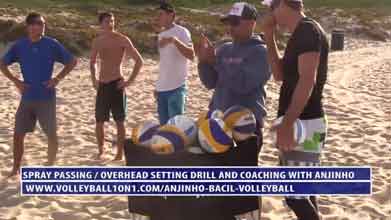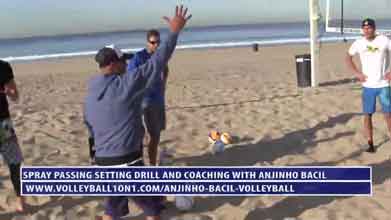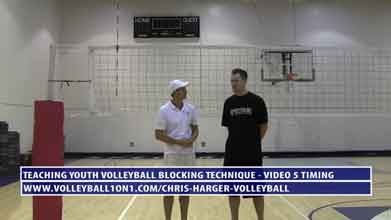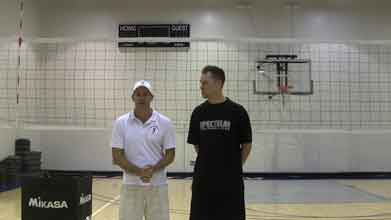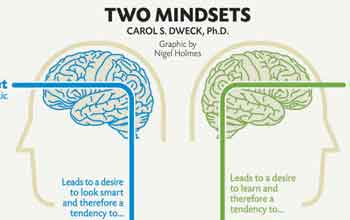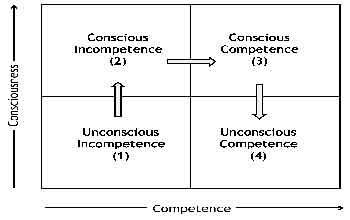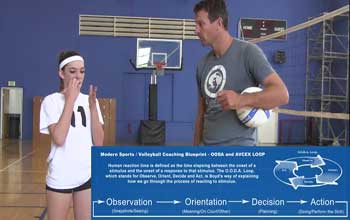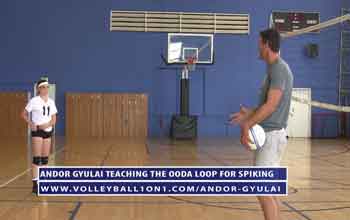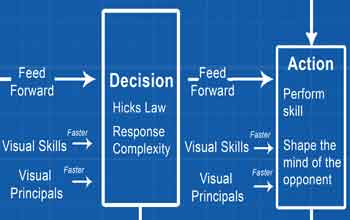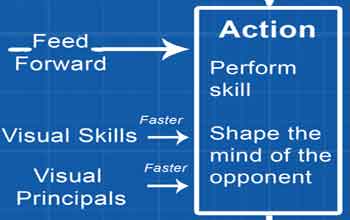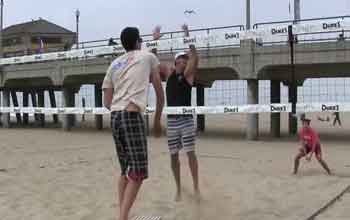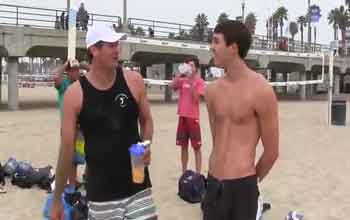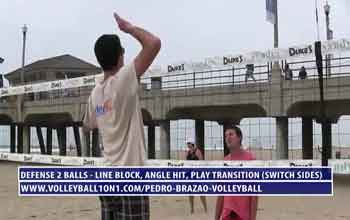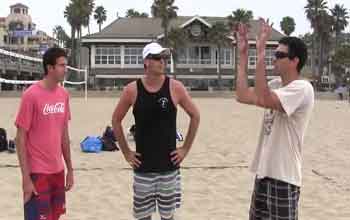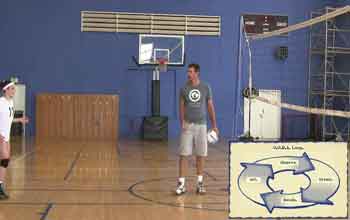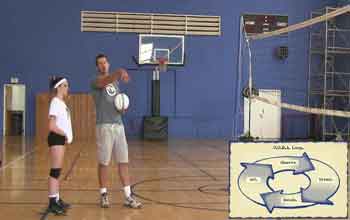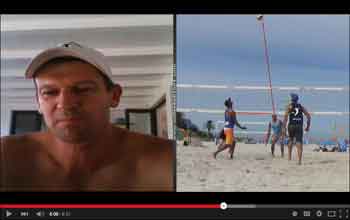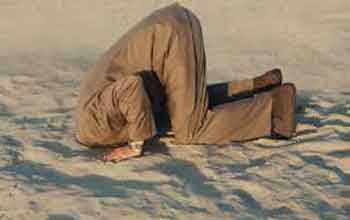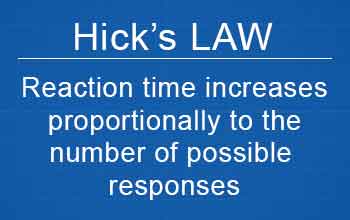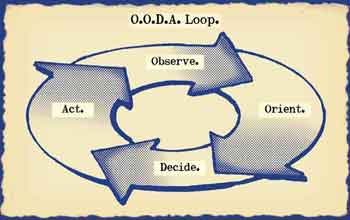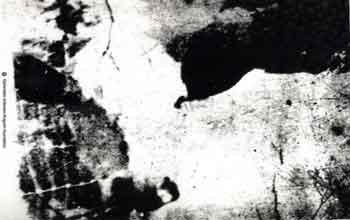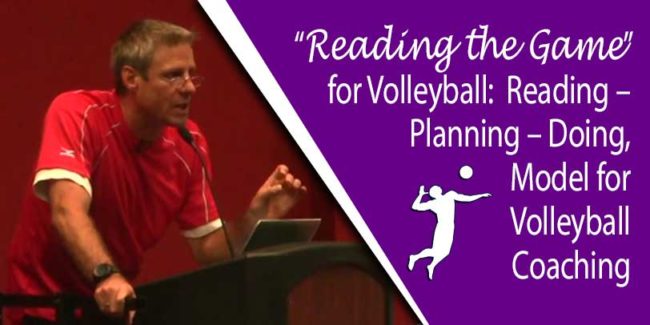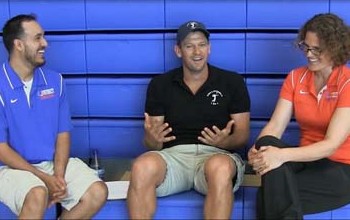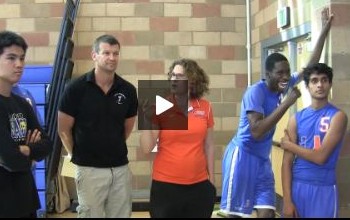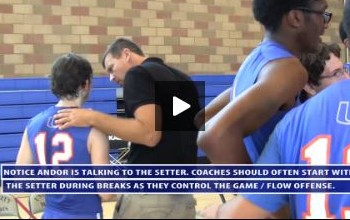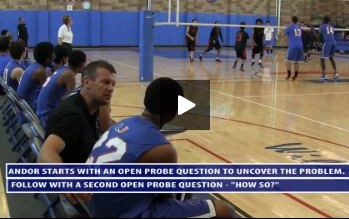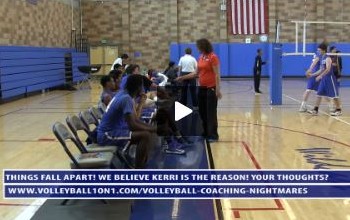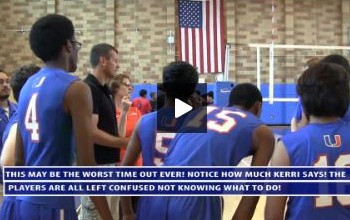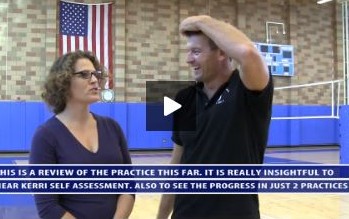Volleyball1on1 offers an incredibly large number of resources on volleyball coaching. This includes help and instruction from top volleyball players and coaches for all skill levels including beginners, youth, middle school, high school, club, college and professional levels.
An important volleyball coaching cue for learning is “Be Engaged”. This verbal cues can be used: when teaching players how to learn faster, participate in practice more, and finally how to make their high school team with a new and different coach.
In this video Andor Gyulai reviews the verbal cues: “Make Lots of Mistakes” and “Look Really Stupid”. These cues can be very helpful for forming a better foundation for learning. We encourage you to review this plus the process of “How people learn”, early during the season and we encourage this to be an important foundation of your teams core principals.
“Reading the game is the premier skill in volleyball” – Karch Kiraly. I DISAGREE! Great players and coaches go beyond “Reading the game” and have or coach the ability to slow the ball and game down after they receive information from their opponents. This FREE Video will show you how to do this successfully!
This video features a continuation and a progression from the previous spray pass drill. Now players not only have to set a bad spray pass, but in some cases the spray pass is so bad they have to set the ball behind themselves. This video also works on player spacing and helps the attacker with where and how to approach a bad pass so they can still maybe be in system or at least get a decent attack in on the bad pass.
This video features the spray pass setting drill and coaching with Anjinho Bacil. A short low pass is a common error when passing the ball infront of your inside leg however at the height Anjinho recommends however practicing this drill results in an easy fix where the setter can improve the play and get the hitter back in system.
In this videos Chris Harger focuses on timing and setting the block as it relates to coaching youth volleyball blocking technique. Points discussed include: timing, where to set the block based upon the attack, tips for blocking the attacker and more.
In this videos Chris Harger focuses on vision and “Reading the game” as it relates to coaching youth volleyball blocking technique. Points discussed include: Visual sequence, ball – setter – ball – hitter, reading the setter, examples; overrunning the ball, dropping their hands, arching the back, set against the flow, reading the hitter, plus more.
During the Orientation Stage of the OODA Loop you are processing what you Observe. Your mindset is thus critical to understanding and getting meaning from what you see. The Growth Mindset is a simple idea discovered by world-renowned Stanford University psychologist Carol Dweck in decades of research on achievement and success. Teaching a growth mindset creates motivation and productivity in the worlds of business, education, and sports, especially volleyball.
This video features Andor Gyulai using the conscious competence learning matrix to help teach a youth player volleyball. In this video the player is moving though stage 1 to stage 2 and stage 3 of the learning curve.
In this video Andor Gyulai demonstrates why he feels the OODA Loop verbal cues are better for coaching volleyball particularly when teaching volleyball skills, reading the game and volleyball strategy. The video addresses a common problem many coaches have helping young players spike better.
In this powerful video the OODA Loop coaching cues are used to help the player discover most of her spiking problems have less to do with technique and more to do with “Reading” and Orientation of the set. The coaching of this is successfully done by Andor using guided discovery and great open probe questions where he is constantly checking in with the players emotionally so that they are not overwhelmed but rather take the feedback as a challenge and a opportunity to grow.
Volleyball players organize their movement patterns when performing a volleyball skill in advance. As the action or skill gets more complex so the reaction time increases as more time is required to organize the system for movement initiation. In this post we explore the idea and give examples.
In volleyball, sports and war shaping the mind of your opponent is critical to winning. John Boyd described as the most influential military theorist since Sun Tzu created the OODA Loop combat training system as a better way to attack the mind of your enemy and win. This proven and tested system is the foundation of most military strategy today and has literally been tested in the trenches to win above all others.
This beach volleyball defense drill features two balls, a line pull and a angle block with a line defense. Each play is played out and the coach Pedro Brazao is hitting off a bench. This video features allot of good verbal cues as well as some good coaching feedback for line defense with an angle block as well as some tips on pulling when blocking.
What’s better to train in for beach volleyball, deep or shallow sand? In this video Andor Gyulai and Miles Evans talk about the difference between training and playing in Manhattan Beach verses Huntington Beach.
This video contains beach volleyball coaching tips for blocking shots plus a 2 ball defense drill with a block and a dig with Brazilian Coach Pedro Brazao coaching. This video is extremely insightful as Pedro discusses a common mistake players make when trying to block shots in beach volleyball. His answer is on point and easy to understand.
This video contains volleyball coaching advice for beach volleyball blocking. Additionally Pedro gives us a quick review of the players skill level and some thought on things the players should improve.
Please keep in mind all the players except Andor Gyulai (Volleyball1on1 Owner) have represented United States for Beach Volleyball. What this means is you are getting to watch and almost semi pro level practice and what the top players do to get better during their volleyball practices!
Physical orientation meaning where you are before you perform a volleyball skill is often critical to performing the volleyball skill correctly. With spiking where you start your approach to hit is often as important as your approach or your spiking technique. Yet few volleyball coaching models account for how players are taking in stimuli “Reading the Game” and reacting to that stimuli before performing the volleyball skill. The OODA Loop and my Modern Volleyball Coaching Blueprint is different as your physical orientation is constantly being accounted for in my model while performing the volleyball skill.
This article contains a video example and verbal cues of how Andor Gyulai teaches volleyball spiking technique using the OODA Loop.
In this video Andor Gyulai points out some common beach volleyball blocking mistakes to avoid. This video also includes tips for “reading the game”, pulling and beach volleyball strategy. This video was filmed in South Africa on his recent trip from Dec 2014 – Feb 2015.
I would like to share an easy to use and easy understand example of how to OODA Loop your opponent using Hick’s law. This example was used on me initially quite effectively by my good friend Colin Pockock (Age 44) in South Africa who is a former beach volleyball Olympian who took a 9th at the 2004 Olympics. I think he is the best beach player in South Africa volleyball history.
Human reaction time is defined as the time elapsing between the onset of a stimulus and the onset of a response to that stimulus. A primary factor affecting a response to stimuli is the number of possible stimuli or in volleyball’s cases what you “Read” your opponent doing. In 1952 a researcher named Hick confirmed that by going from one response choice (Decision Step) to two, response time increased by 58%…
Today I want to share what is a fundamental shift in the way I feel volleyball should be taught! The ideas I will be sharing today build on coaching concepts first introduced by Karch Kiraly and others known as “Reading the Game”. After over 3 years of research through my own observations as a player…
After over 3 years of research through my own observations as a player and coach I realized the Reading – Planning – Doing system can be vastly improved, specifically how we as coaches teach players the process of how we as humans respond to stimuli (predominantly with our eyes), which is the basis of how all volleyball skills and sports are performed.
Did you know one of the biggest breakthroughs in the “science of coaching volleyball” today is called “Reading the Game”? Most of the ideas related to this were first introduced by Karch Kiraly (considered the greatest volleyball player in the sport) on his retirement and transition into coaching just a few years ago during a presentation at an AVCA Convention in San Antonio, Texas.
In our work with Dr. Bill Harrison (Sports Eye Doctor to Top Sports Stars) we have discovered humans cannot think and see at the same time! Yet many coaches ignore this fact and because of their own coaching styles and lack of knowledge about vision actually negatively impact their players on the court during matches.
This is the end match team review at Uni High. You will notice Kerri really trying hard to ask open probe questions in order to engage the players. In evaluating I think most viewers will agree she is soliciting more interaction and engagement from the team than she did in the past.
This video was filmed between Set 1 and Set 2 of the match. This is another powerful video which reveals how Andor makes the most use of the limited time focusing on specific players and goals as well as changing the collective energy of the group. Again you will notice the Socratic method of coaching and how Andor takes the players down a path that he wants. This video shows how brilliant coaches interact with their team changing the collective energy during breaks.
Andor is a big believer in “On the Bench Coaching”. In this video viewers will see how Andor interacts and communicates with players on the bench and some of the topics he focuses on. If you are a coach looking to have a bigger impact in the lives of players beyond just playing volleyball this video shows how easily and effectively “On the Bench Coaching is”.
This 4 video series features Andor Gyulai reviewing Uni High Volleyball Coach Kerri Eich coaching a match. This post is extremely insightful as it reveals many common match volleyball coaching mistakes former player make when coaching. The video also brings to light what a coaches real goals should be during a match and what should be focused on and when.
This is a great video showing a good timeout speech by a coach verses a bad timeout speech when coaching youth volleyball. You will notice once coach talking about allot of different things to allot of player with allot of focus on the performance of skills. The other coach does the opposite. In the comments below let us know what you think?
In this video Kerri and Andor review mid way through practice the speed of change and improvement of team at Uni High. Also discussed are some of the strategies that have worked thus far plus some specific coaching philosophies!
